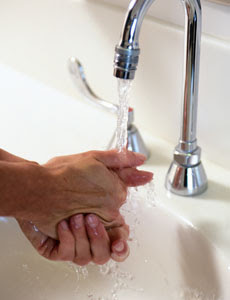 Are you running the tap waiting for the hot water to arrive? We know. It's inconvenient - and a waste of both water and money. But what are ya' gonna do?
Are you running the tap waiting for the hot water to arrive? We know. It's inconvenient - and a waste of both water and money. But what are ya' gonna do?
Well, a hot water recirculation system could be just the ticket.
Think about it. You may not run the hot water all day long while the family is away from home at work and school. During that time, heated water lays in the line cooling off. Then when you do get home - or up in the morning - and need the hot water, all that unused and now tepid water needs to be run through the line - and down the drain - before fresh hot water reaches the faucet.
It's goofy.
With a recirculation system, water temperature is maintained in the line when you need it most. At Boden Plumbing, we like the Grundfos Comfort System. It's a straightforward install and easy to maintain. The pump attaches to your hot water heater and a small return valve is unobtrusively installed on the furthest faucet in the home. Since the existing lines are used, there's no added expense for additional lines. Then timers keep that hot water circulating in the pipes just when you need it most - saving time, energy, water. You name it.
If you'd like more information, call the shop. Or log onto the Grundfos site to learn more.
:: the Grundfos recirc system
:: PG&E energy calculators
Friday, September 28, 2007
Got Hot Water?
Posted by The Team at Boden 0 comments
Labels: hot water recirc pump
Wednesday, September 12, 2007
Don't Get Caught without an Earthquake Valve

We don't mean to be alarmist - really we don't. But let's be realistic. Stuff happens. The good thing is some "stuff" we can prepare for and mitigate - even some of the big stuff. Like earthquakes.
Earthquakes are one of those inevitable eventualities that no one who lives in faulty areas can run or hide from. Besides structural failures, perhaps the biggest danger when an earthquake strikes is fire. In particular, fire from ruptured gas lines.
A gas shut-off valve is a smart addition to any building located in earthquake country. Triggered automatically by the shaking of a temblor, they quickly cut off the supply of gas to the building, which greatly reduces the risk of fire – a very good thing! In fact, many insurance companies in California now require installation of a gas shut-off valve before writing new policies.
The valve is installed outside on your gas line, near where the line enters your home, and it's on duty whether you're home or not. The cost of installation varies depending on conditions at your particular property and there are a couple of options to choose from, but it's a pretty straightforward procedure. Call us with any questions - we'd be happy to give you an estimate. You can contact us at 707.996.8683 or e-mail us at info@nodrips.com.
:: www.nodrips.com
Posted by The Team at Boden 0 comments
Labels: earthquake valve







